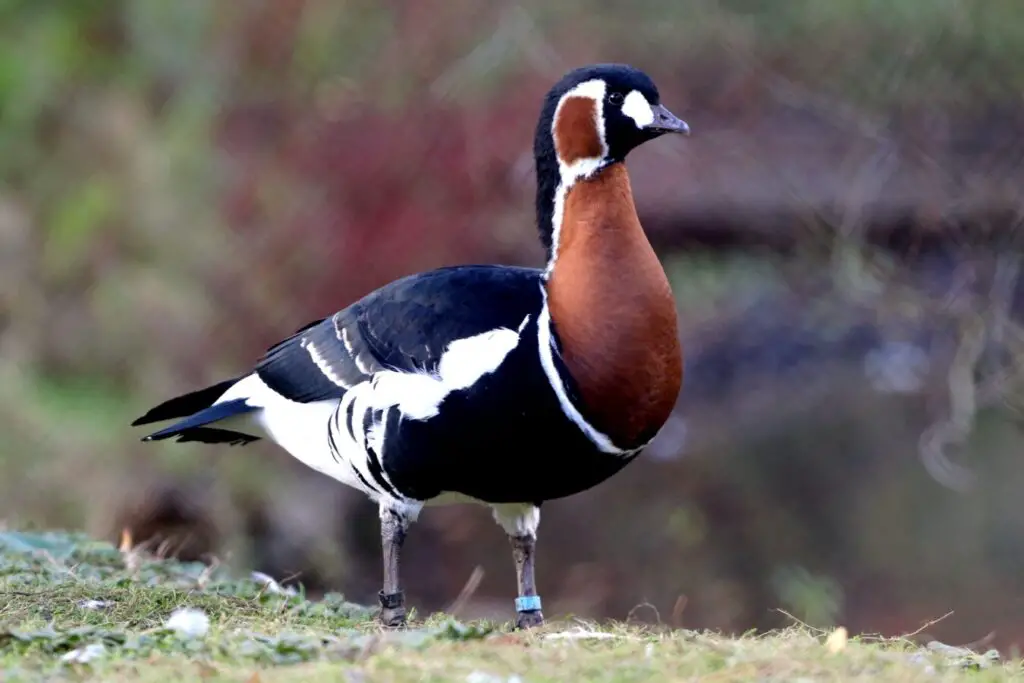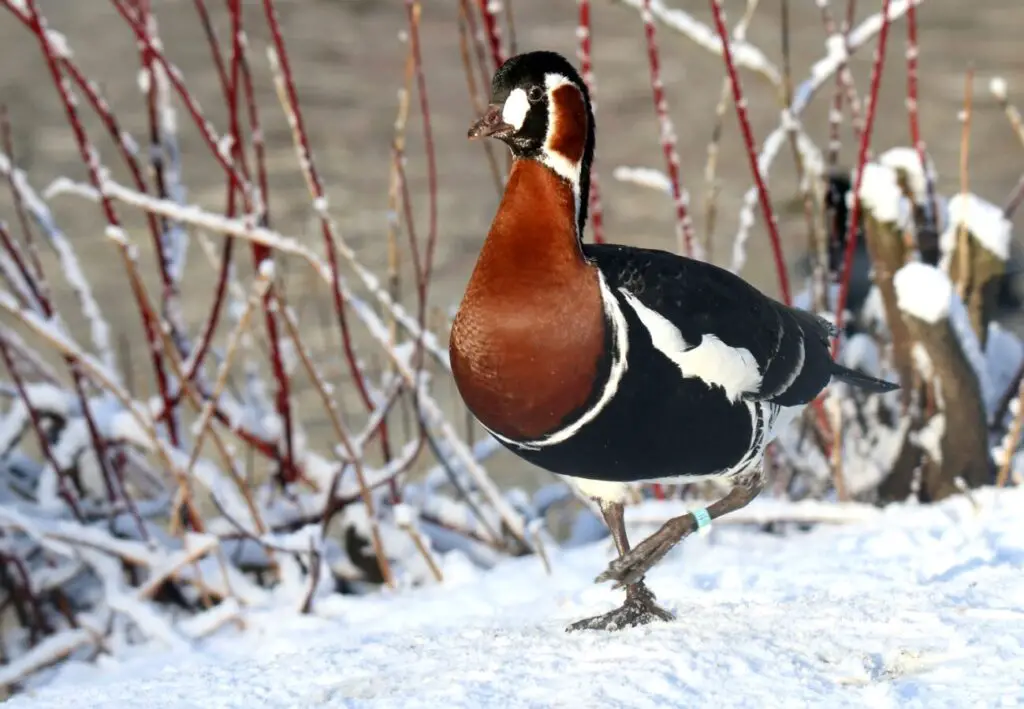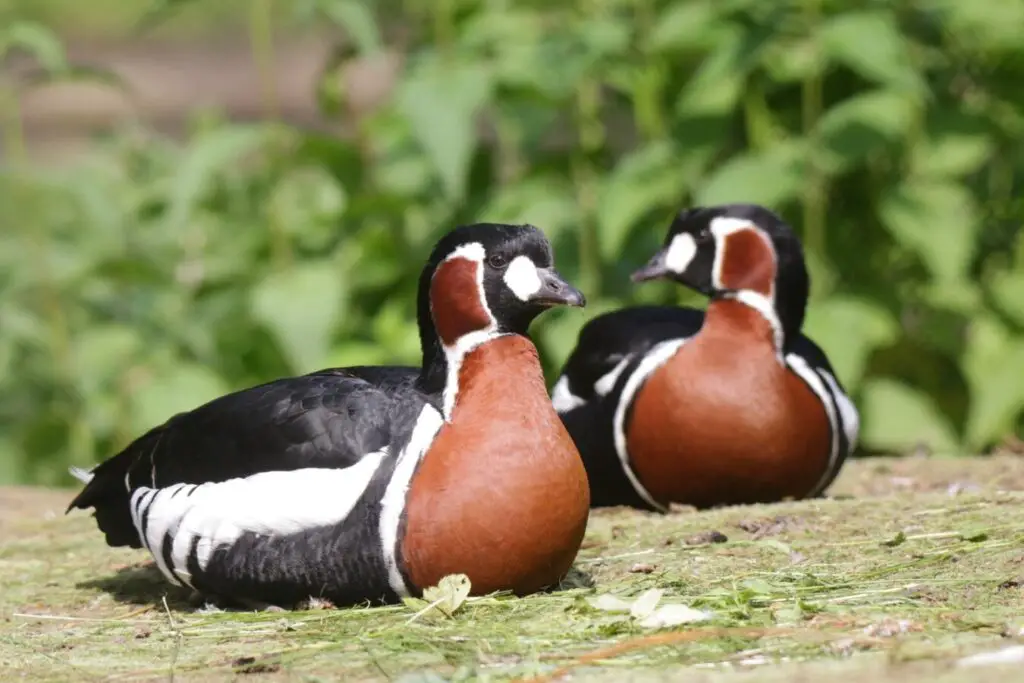As you venture into the realm of ornithology, you’re likely to stumble upon the enigmatic Red Breasted Goose – but how well do you really know this Arctic tundra inhabitant? Like a whispered secret, the truth about its rarity lingers just out of earshot. With estimates suggesting a global population of only 50,000 to 60,000 individuals, it’s clear that this species is teetering on the edge. But what’s driving its precarious existence? Is it the habitat fragmentation, the threats of climate change, or something more? The answer, much like the goose itself, remains elusive – for now.
Key Takeaways
- The Red Breasted Goose is not currently considered a rare species, with a global population estimate of around 50,000 to 60,000 individuals.
- However, the species has experienced significant population declines in the past due to overhunting and habitat destruction.
- Conservation efforts in the mid-20th century led to a moderate increase in population size, but new threats like climate change and habitat fragmentation have contributed to another decline.
- Habitat protection plans and sustainable land-use planning aim to preserve the species’ natural environments and balance human needs with environmental concerns.
- Despite conservation efforts, the species remains vulnerable, and its population trend is uncertain, making continued conservation efforts crucial for its survival.
Historical Population Trends
Tracing back to the 19th century, records of the Red Breasted Goose‘s population trends reveal a precarious balance between growth and decline.
You’ll find that fossil records and historical accounts provide valuable insights into the species’ demographic fluctuations.
During the 19th and early 20th centuries, the Red Breasted Goose population experienced a significant decline, primarily due to overhunting and habitat destruction.
However, conservation efforts in the mid-20th century led to a moderate increase in population size.
Unfortunately, this growth was short-lived, as the species faced new threats, such as climate change and habitat fragmentation, which contributed to another decline.
You’ll notice that the historical accounts of the Red Breasted Goose’s population trends are marked by periods of instability, with the species struggling to maintain a stable population size.
It’s essential to understand these historical trends to inform current conservation strategies and ensure the long-term survival of the Red Breasted Goose.
Habitat and Geographic Range

As you explore the Red Breasted Goose‘s population trends, you’ll find that understanding its habitat and geographic range is vital to grasping the species’ overall dynamics.
The Red Breasted Goose inhabits Arctic tundra landscapes and wetlands, where it breeds and migrates. Its breeding grounds stretch from the northernmost parts of Europe to western Siberia, covering areas such as Norway, Sweden, Finland, and Russia.
During the winter months, the species migrates to the Black Sea and the Caspian Sea regions, as well as parts of Eastern Europe and the Middle East.
The Red Breasted Goose’s habitat consists of Arctic wetlands, including marshes, bogs, and shallow lakes. These areas provide essential resources for the species, including food, shelter, and breeding grounds.
The goose’s adaptation to these harsh, cold environments is critical to its survival. As you delve deeper into the species’ habitat and geographic range, you’ll gain a better understanding of its unique characteristics and the challenges it faces in its natural environment.
Confusion With Similar Species
When you’re identifying a Red Breasted Goose, you’ll need to be careful not to confuse it with similar species, as misidentification risks are high.
You’ll want to pay close attention to physical characteristics, such as the bird’s size, plumage, and beak shape, to ensure an accurate identification.
Misidentification Risks
Misidentification risks lurk in the shadows of every birdwatcher’s expedition, awaiting the perfect moment to strike.
You’re observing a flock of geese, and amidst the chaos, it’s easy to mistakenly identify a red-breasted goose. Flock dynamics can be deceiving, as birds often intermingle, making it challenging to pinpoint a specific species.
Species ambiguity arises when you’re faced with similar-looking birds, such as the greylag goose or the white-fronted goose, which share physical characteristics with the red-breasted goose.
You must remain vigilant and attentive to details to avoid misidentification. Be aware of the surrounding environment and the behaviors of the birds you’re observing.
Take note of the flock’s composition, as red-breasted geese often associate with other species. Additionally, pay attention to the birds’ vocalizations, as each species has distinct calls.
Physical Characteristics
Pinpointing the physical characteristics of the red-breasted goose can be a daunting task, especially when similar species come into play.
You’ll need to examine the bird’s plumage variations closely, as they can be subtle. The red-breasted goose’s distinctive reddish-brown breast and belly feathers can be mistaken for the Lesser White-fronted Goose‘s pinkish-brown coloration.
However, the latter has a more extensive white forehead patch, which can help you distinguish between the two.
Another key characteristic to look for is the beak shape. The red-breasted goose’s beak is typically shorter and more stout than that of the Lesser White-fronted Goose.
You should also note the color of the beak, as it can vary from orange to pinkish-red. By paying close attention to these physical characteristics, you can increase your chances of accurately identifying a red-breasted goose.
Migration Patterns and Sightings

The Red-breasted Goose’s migration patterns are complex and varied, with different populations exhibiting distinct behaviors.
You’ll notice that some populations migrate in large flocks, while others travel in smaller groups or even solo.
- They migrate from their breeding grounds in the Arctic tundra to their wintering grounds in Eastern Europe, the Middle East, and North Africa.
- Their flight routes often take them over major stopovers, such as the Black Sea and the Caspian Sea, where they rest and refuel.
- Some populations make non-stop flights of over 2,000 miles, crossing entire countries in a single flight.
- You may spot them in wetlands, grasslands, and agricultural areas during their migrations, particularly in areas with abundant food sources.
Their migration patterns are influenced by factors like food availability, weather, and habitat quality, making their journeys highly adaptable and dynamic.
Conservation Efforts and Status
You’re about to explore the conservation efforts in place to protect the Red Breasted Goose.
You’ll examine habitat protection plans, which aim to preserve the species’ natural environments, and analyze global population trends to understand the effectiveness of these initiatives.
Habitat Protection Plans
Protected wetlands and grasslands serve as sanctuaries for the Red Breasted Goose, where conservation efforts focus on preserving habitats critical to its survival.
You’ll find these protected areas in regions where human impact is most significant, and community engagement is crucial to the success of these initiatives.
To ensure the Red Breasted Goose’s habitat remains intact, conservationists implement the following measures:
- Sustainable land-use planning: Balancing human needs with environmental concerns, you’ll find zoning regulations that restrict development in sensitive areas.
- Wetland restoration: Revitalizing degraded habitats by reintroducing native vegetation and removing invasive species.
- Grassland management: Implementing controlled grazing practices and periodic burning to maintain the natural balance.
- Invasive species control: Eradicating non-native species that compete with the Red Breasted Goose for resources.
- Monitoring and research: Continuously studying the habitat’s ecological health and adapting conservation strategies accordingly.
Global Population Trends
Across its range, conservation efforts have led to a stabilization of the Red Breasted Goose‘s global population, with estimates suggesting around 56,000-70,000 individuals.
You’ll notice that this stabilization is a result of effective species adaptation to changing environmental conditions.
In terms of population dynamics, the Red Breasted Goose’s numbers have been trending upward in certain regions, such as the Russian tundra, where habitat protection plans have been successfully implemented.
Conversely, populations in other areas, like the Ukrainian steppes, are still declining due to ongoing habitat degradation.
Despite these regional variations, the overall global population trend is one of stability, indicating that conservation efforts are having a positive impact.
As you examine the data, you’ll see that the Red Breasted Goose’s population dynamics are closely tied to habitat quality and availability.
Threats to Survival and Habitat

While the Red-breasted Goose’s unique characteristics set it apart from other geese species, its survival is threatened by various human activities and natural factors that compromise its habitat.
As you explore the Red-breasted Goose’s world, you’ll find that human impact and climate shifts are major contributors to its decline.
Some of the key threats to the Red-breasted Goose’s survival and habitat include:
- Habitat destruction and degradation due to agriculture, urbanization, and infrastructure development
- Human disturbance and fragmentation of habitats, causing population isolation
- Climate shifts altering vegetation and water availability, affecting food sources and breeding grounds
- Hunting and poaching, particularly in migratory routes and wintering grounds
- Collisions with power lines and wind turbines, leading to mortality and injury
Breeding and Nesting Habits
Nearly 30,000 Red-breasted Geese migrate to their breeding grounds each year, where they engage in unique breeding and nesting habits.
You’ll find that mate selection plays a crucial role in their breeding process. During the spring migration, you’ll observe males performing elaborate courtship displays to attract females. These displays typically involve loud calls, aggressive posturing, and elaborate feather displays.
Once paired, the male and female will form a strong bond, often remaining together for multiple breeding seasons.
As you observe their nesting habits, you’ll notice that Red-breasted Geese typically nest in small depressions on the ground, often lined with vegetation and down.
The female lays an average of 3-5 eggs, with an incubation period of around 24-26 days. After hatching, the brood size averages around 2-3 goslings, which will fledge at around 30-40 days old.
Throughout the breeding season, you’ll see both parents taking turns incubating eggs and caring for their young, a testament to their strong parental bond.
Population Estimates and Data

As you delve into the world of Red-breasted Geese population dynamics, you’ll find that estimates suggest around 50,000 to 60,000 individuals comprise the global population.
This number is based on data collected from various sources, including bird counts, surveys, and research studies. However, it’s essential to acknowledge that population estimates can be subject to certain limitations and uncertainties.
Some key aspects to consider when evaluating Red-breasted Goose population data include:
- Data gaps: There may be a lack of comprehensive data for certain regions or time periods, which can impact the accuracy of population estimates.
- Research limitations: Methodological limitations, such as biases in survey methods or incomplete coverage, can also affect the reliability of population data.
- Habitat fragmentation: The fragmented nature of the species’ habitat can make it challenging to obtain accurate population estimates.
- Migration patterns: The Red-breasted Goose’s migratory behavior can make it difficult to track and count populations accurately.
- Counting methods: Different counting methods, such as aerial surveys versus ground-based counts, can produce varying results.
Future Outlook and Projections
You’re now looking at the future of the Red-breasted Goose population, and projections suggest that conservation efforts will play a critical role in shaping the species’ trajectory.
As you consider the outlook for this species, it’s essential to acknowledge the impact of climate change on its habitats and behavior. Climate resilience will be crucial in ensuring the long-term survival of the Red-breasted Goose.
Adaptive management strategies will be vital in responding to the dynamic nature of climate-driven changes.
This approach involves continuous monitoring, assessment, and adjustment of conservation measures to optimize their effectiveness. By integrating climate models, habitat assessments, and demographic data, conservationists can develop targeted interventions to enhance the species’ resilience.
In the short term, habitat preservation and restoration efforts will focus on protecting key breeding and migratory sites.
In the long term, assisted colonization and translocation programs may be necessary to facilitate range shifts in response to changing climate conditions.
FAQs: Red Breasted Goose
Can Red Breasted Geese Be Found in Urban Areas or Cities?
You can find Red-breasted Geese in urban habitats, particularly during migration, but they rarely inhabit city dwellings; instead, they prefer wetlands, grasslands, and agricultural areas near urban centers, where they can forage and roost safely.
Are Red Breasted Geese Known to Be Aggressive Towards Humans?
When encountering red breasted geese, you’ll find they can be aggressive towards humans, especially during breeding or nesting seasons, as they defend their territory and young, reacting to human behavior perceived as threats during these sensitive goose encounters.
Do Red Breasted Geese Have Any Natural Predators in the Wild?
As you venture into the wetlands, you’ll discover that red breasted geese have natural predators like foxes and owls lurking in the shadows. To survive, they rely on habitat protection and clever predator avoidance strategies, such as concealing their nests and staying vigilant.
Can Red Breasted Geese Be Domesticated or Kept as Pets?
You’ll find that domesticating red breasted geese is challenging due to their complex flock dynamics; additionally, breeding regulations often prohibit keeping them as pets, and even experienced breeders face difficulties in replicating their natural habitat and social structures.
Are Red Breasted Geese Considered a Delicacy in Any Cuisine?
As you savor the world’s culinary delights, you’ll discover that red breasted geese are prized for their exotic flavors, often featured in high-end game meats dishes, particularly in European and Asian cuisines, where they’re considered a delicacy.
Conclusion
As you gaze upon the Red Breasted Goose, remember that its existence hangs precariously in the balance, like a delicate thread straining under the weight of human actions. Conservation efforts are the lifeline that can steady this thread, but it’s up to us to ensure the species doesn’t become a fleeting memory. With continued support and protection, the Red Breasted Goose can thrive, but the clock is ticking, and every moment counts in the fight against extinction.













